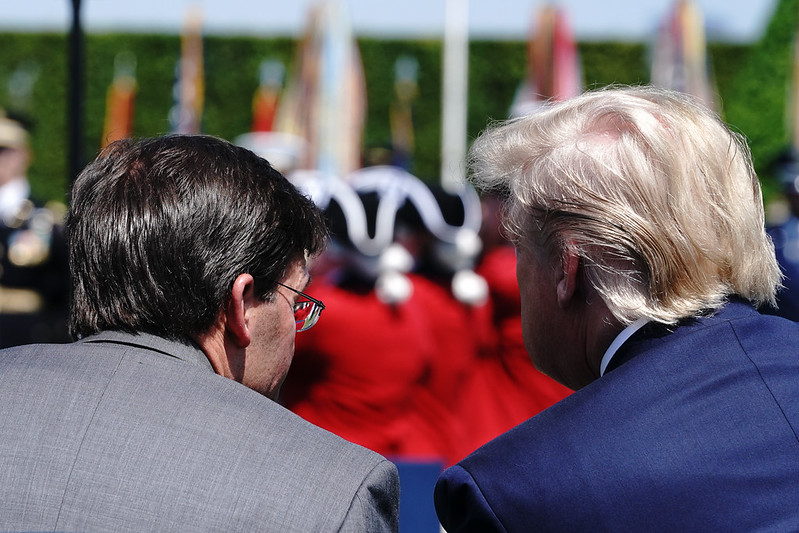Soleimani and the Tactical Execution of Strategic Self-Defense

Published by The Lawfare Institute
in Cooperation With

The United States claims to have “exercised its inherent right of self-defense” in accordance with Article 51 of the U.N. Charter in conducting a drone strike in Iraq targeting Iranian Major General Qassem Soleimani. Most commentators have similarly focused on jus ad bellum questions: whether the strike met the requisite standards of imminence, necessity and proportionality and whether Soleimani—the commander of the Quds Force, a military unit within Iran’s Islamic Revolutionary Guard Corps specializing in unconventional warfare—qualified as a legitimate military target under the law of armed conflict. But at least one prominent international law expert recently asserted that those standards—imminence, in particular—were “irrelevant” to the question of the strike’s legality under international law.
In his recent Lawfare post, Michael Glennon contends that there was no basis for the U.S. to invoke targeting principles derived from the law of armed conflict because the Iranian armed attack the U.S. ostensibly assessed as “imminent” had not yet been conducted. In other words, because no armed conflict existed at the time the U.S. targeted Soleimani, the U.S. attack violated the U.N. Charter, even if it was executed to preempt an imminent Iranian armed attack directed under Soleimani’s command and control. We believe this interpretation is deeply flawed. It defies the rules governing the tactical execution of an invocation of strategic self-defense authority and cuts against both historic practice and common sense.
We do not wish to assess whether the U.S. claim of a jus ad bellum justification for the strike was based on a credible imminence assessment or whether the decision was consistent with the requirements of necessity and proportionality. We believe the inquiry and debate on these questions is, contrary to Glennon’s assertion, not only relevant but the dispositive questions to assess the validity of the asserted U.S. legal justification. Instead, we write to raise what we believe is a critical question that Glennon’s “imminence irrelevance” theory seems to simply bypass: Which international law regulates tactical execution when a state employs military force to intercept or preempt an imminent armed attack pursuant to Article 51’s inherent right of individual or collective self-defense?
This, we believe, is a critically important question. Glennon asserts that the killing of Soleimani was unlawful even assuming arguendo the attack was an exercise of the inherent right of self-defense. If Glennon’s assertion is accurate, then the state must constrain tactical execution to measures consistent with peacetime use of force rules and may use military force pursuant to the law of armed conflict only after it has suffered the consequences of the imminent armed attack. Glennon’s argument implies that, even assuming the U.S. acted in order to preempt an imminent armed attack (in a fashion usually considered to be consistent with the Article 51 right of self-defense), the strike was per se a violation of the U.N. Charter because the U.S. was not in an armed conflict at the time it conducted the attack on Soleimani.
It follows from Glennon’s argument that the strike is legally indistinguishable from a strike on any other foreign government official in the territory of another nation during a time of peace. Glennon’s argument means that preemptive self-defense is no longer a legally viable claim.
This view of the legal framework governing a state’s execution of the inherent right to self-defense explains why Glennon has joined the chorus of commentators characterizing the attack that killed Soleimani as an “assassination.” But this characterization seems invalid if the credible threat of an imminent Iranian armed attack indeed qualified as triggering an armed conflict and Soleimani was reasonably assessed as a military operational leader of the entity planning to conduct that attack and a legitimate military target. Thus, we agree with Shane Reeves and Winston Williams that “[the]debate over whether the action was an assassination is unhelpful in determining whether there was a legal basis under international law for the air strike.” The legal basis for the U.S. airstrike was the assessed imminence of an unlawful Iranian armed attack. Whether the individuals targeted to preempt that imminent threat were subject to an “assassination” (meaning an unlawful killing) or were themselves lawful objects of attack (the antithesis of assassination) turns on the secondary question: Was the killing a lawful tactical execution of that self-defense justification? In other words, does the law of armed conflict or peacetime international law govern the killing? For us, the answer to that question is clear: When a state employs military force to defend itself against an imminent armed attack, tactical execution is regulated by the law of armed conflict.
The assertion that the attack against Soleimani was an assassination presupposes the inapplicability of the law of armed conflict. But this suggests an odd legal equation: that applicability of the law of armed conflict includes some type of inherent “offer and acceptance” principle that it is not until the state is the victim of an actual armed attack that its “acceptance” in the form of military response qualifies as an armed conflict. We believe this is an erroneous interpretation of the armed conflict triggering threshold. In our view, if a state reasonably determinesthat military action is necessary to intercept or preempt an imminent armed attack, that military action indicates the existence of an armed conflict. Thus, jus in bello rules govern the tactical execution of military action to achieve that self-defense objective, including who and what qualifies as a lawful object of attack.
Glennon’s attempt to support his argument with reference to the U.S. military’s World War II killing of Admiral Isoroku Yamamoto—the architect of the Pearl Harbor attack and commander in chief of the Japanese Navy—seems equally misplaced. Drawing a contrast between the U.S. attack on Yamamoto and the attack on Soleimani indicates the belief that the law of armed conflict has no relevance to the legality of a military response to an imminent armed attack, but only to military action after that armed attack has been conducted. Glennon claims that “Admiral Yamamoto’s plane was a legitimate military target” only because the engagement was during an ongoing armed conflict. We certainly agree that Yamamato was a legitimate military target. But Glennon’s broader contention is that Yamamoto, unlike Soleimani, qualified as a lawful subject of attack because the armed conflict in question was already ongoing.
Consider the import of Glennon’s approach. Imagine that on December 6, 1941, the United States learned of an imminent Japanese armed attack on the U.S. Navy at Pearl Harbor, that Yamamoto had planned the attack and was in command of the forces that would carry out the attack. Imagine that in this situation, the U.S. had the ability to launch a targeted strike against Yamamoto in self-defense. According to Glennon, such U.S. action would be illegal under international law as Yamamoto could not yet be characterized as a lawful object of attack but instead was a government official in a status no different from a diplomat encountered during a time of peace. One wonders what Professor Glennon thinks a state should do under those circumstances once it reasonably assesses the imminence of an armed attack? Attempt to arrest the enemy operational commander? File a diplomatic demarche? Or patiently await the attack and potential injury and death of its citizens and damage and destruction to its property? Not only are such options illogical, they are not consistent with the practice nor law of self-defense.
There are of course other examples besides that historical counterfactual. During the last two decades of the Cold War, there was growing public and political momentum in the United States to disavow any “first use” of nuclear weapons—that the U.S. should adopt a policy that it would use these weapons only after a nuclear attack from the Soviet Union. But why did every U.S. president, not to mention our NATO allies, resist this effort? The answer seems clear: because they knew that if presented with intelligence indicating an imminent Soviet nuclear attack, the United States was prepared to act in self-defense to preempt that imminent threat by attacking a wide range of strategic and operational targets. Those attacks would have been conducted pursuant to the law of armed conflict because few would question that the legitimate assessment that an attack was coming and the subsequent use of force in self-defense would indicate the existence of an armed conflict. And, although on a scale far greater than the Soleimani attack, our missiles would have legitimately targeted enemy military leadership and the command, control and communications capabilities those leaders relied on to conduct their own military operations.
Ultimately, we believe there is great risk in confusing the function of the two branches of the jus belli. The jus ad bellum dictates the strategic legality and scope of a state’s use of military force in self-defense. Imminence is not only relevant to the exercise of this strategic inherent right, it is an essential predicate—along with necessity, proportionality and a legitimate military target—for any responsive use of force to qualify as lawful. The determination that the state faces an imminent armed attack and employs force in self-defense therefore represents an ipso facto determination that the situation qualifies as an armed conflict triggering the jus in bello for purposes of regulating the tactical execution of defensive operations. Thus, when a state invokes self-defense authority and uses force, it triggers jus in bello, and the tactical execution of military action to achieve the strategic self-defense objective is governed by the law of armed conflict. The relevant question then becomes whether the individual is a legitimate target. Where a military officer in command of the forces and capabilities creating the imminent threat of armed attack is lawfully and successfully subjected to attack, the killing was legally justified.
At a minimum, with the first “shot fired”—the first missile the U.S. launched—an armed conflict between the U.S. and Iran existed. At the time Soleimani was targeted, there seems to be no credible basis to conclude that he did not qualify as a legitimate military target. His role as the operational commander of the unconventional forces triggering the U.S. right of self-defense rendered him a lawful target pursuant to the law of armed conflict. Accordingly, the imminence of the armed attack he was ostensibly orchestrating was indeed relevant to the assessment of attack legality. That imminent armed attack triggered the Article 51 right of self-defense, and the U.S. responsive use of force triggered the law of armed conflict. The only way imminence could be irrelevant is if there was no armed conflict until after the United States conducted its attack. Interpreting international law to reach that conclusion would produce a fundamental and profoundly troubling gap between the manner in which states defend themselves against imminent threats of armed attack and the law they are obligated to respect.






